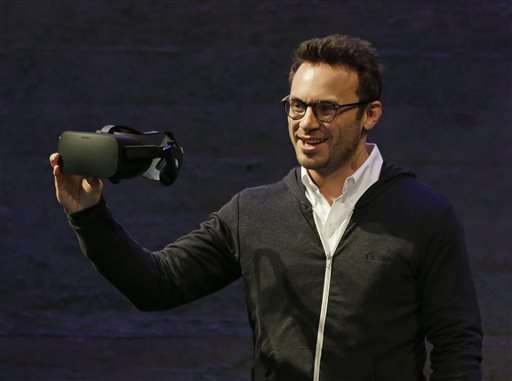In this Thursday, June 11, 2015 file photo, Oculus CEO Brendan Iribe holds up the new Rift virtual reality headset during a news conference in San Francisco. Oculus is hosting its second annual conference for virtual reality developers, running Sept. 23-26, 2015, in Los Angeles. The company is scheduled to release the consumer edition of its Oculus Rift VR headset early next year. (AP Photo/Eric Risberg, File)
Before a planet in a galaxy far, far away is completely constructed inside a computer or entirely built somewhere in the real world, "Star Wars" filmmakers are now able to visit it in virtual reality before production commences.
Rob Bredow, a Lucasfilm visual effects supervisor and head of the ILM Experience Lab, showed off a prototype program Wednesday at an industry gathering of VR creators. The program, called V-Scout, allows filmmakers to virtually experience mocked-up sets on an iPad and Oculus Rift VR headset.
Bredow demonstrated the prototype at the Oculus Connect conference with a visit to the desert planet Jakku that will be featured in director J.J. Abrams' "Star Wars: The Force Awakens."
"The idea here is that you can mock up your shots very intuitively if you're the director, the director of photography or anybody in the filmmaking process before you've gone out and planned anything in any detail," said Bredow. "In this case, we're just looking at sketch models, low-quality models that the art department mocked up early in the production to work on blocking and scale."
During the demo, finger motions on an iPad were used to sweep around a downed Star Destroyer in order to frame a shot. At one point, the Oculus Rift headset was used to simulate standing on top of the massive space vessel to illustrate the ship's height above the sandy wasteland below.
Bredow said Gareth Edwards, director of the spin-off film "Star Wars: Rouge One," has been using the technology before constructing sets.
In addition to V-Scout, Bredow also showcased a quirky computer-generated, 360-degree demo featuring iconic "Star Wars" characters C-3PO and R2-D2.
In the footage, the rebel droids were hiding from Stormtroopers on the planet Tatooine. The footage was first shown as a linear short film before Bredow employed touch controls on an iPad to navigate past the plot's main action, revealing bounty hunter Boba Fett lurking in the background and an AT-AT combat vehicle attacking a rebel ship off in the distance.
"We've taken pieces that might have ended up on the cutting room floor and are exploring them in this new medium," said Bredow. "It feels natural. You don't have to teach someone to use this—and it's all running on an iPad."
Bredow noted that despite any perceived similarities, the immersive form of storytelling is neither film nor video game. It's a new medium that exists somewhere between them.
"We're letting you do everything but change the story," said Bredow. "You can change the wind, lighting, all of that, but not the story because we're making the assumption in this test that you don't want to change the story. You want to be told a great story and see other things that complement that."
Lucasfilm and visual effects studio Industrial Light and Magic launched ILMxLAB earlier this year to create such immersive entertainment prototypes, although their potential commercial viability is unclear. The division has so far released 360-degree promotional content featuring creatures and locales depicted in such films as "Jurassic World," ''Warcraft" and "The Force Awakens."
More information: www.ilmxlab.com
© 2015 The Associated Press. All rights reserved.
























